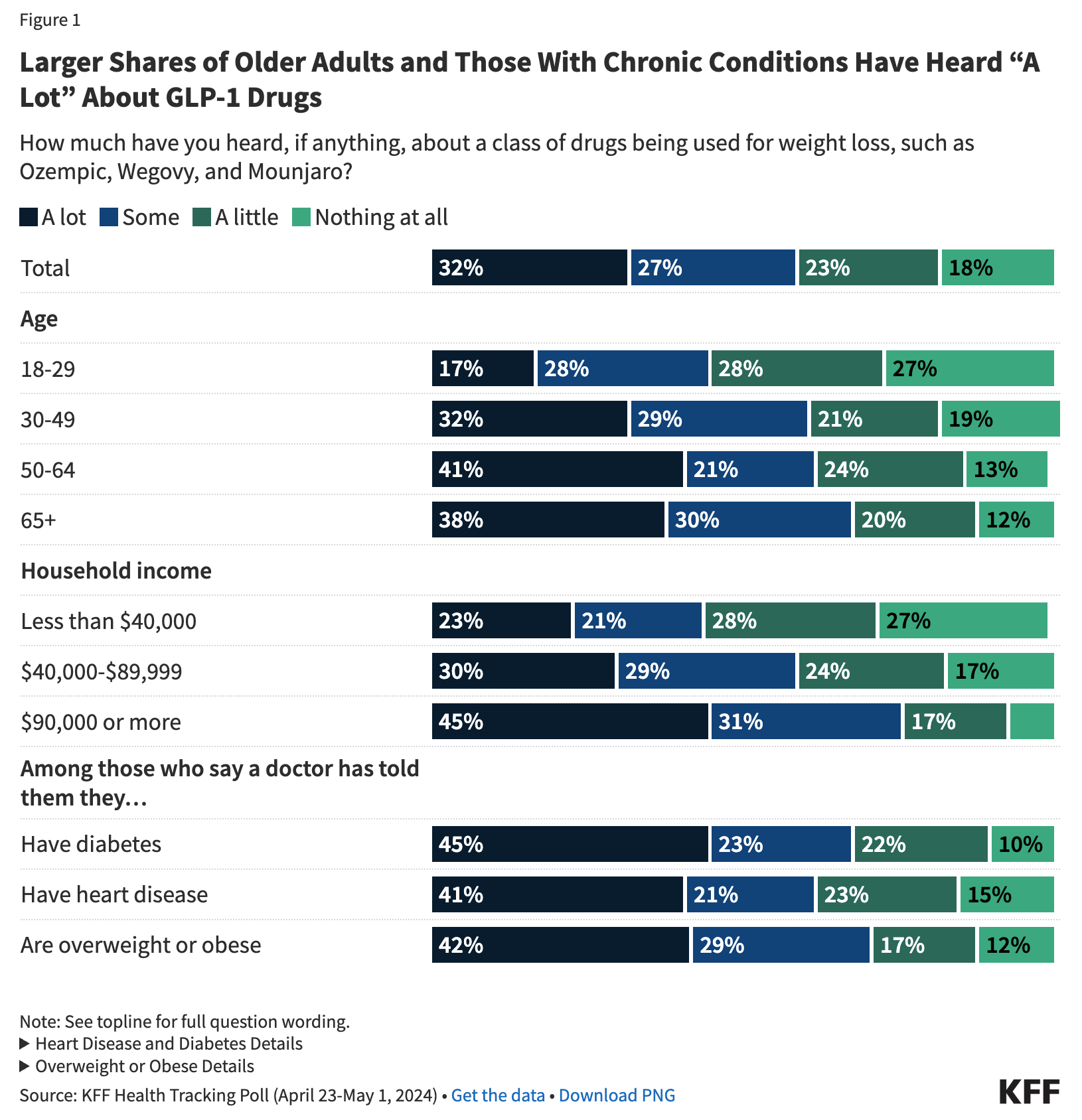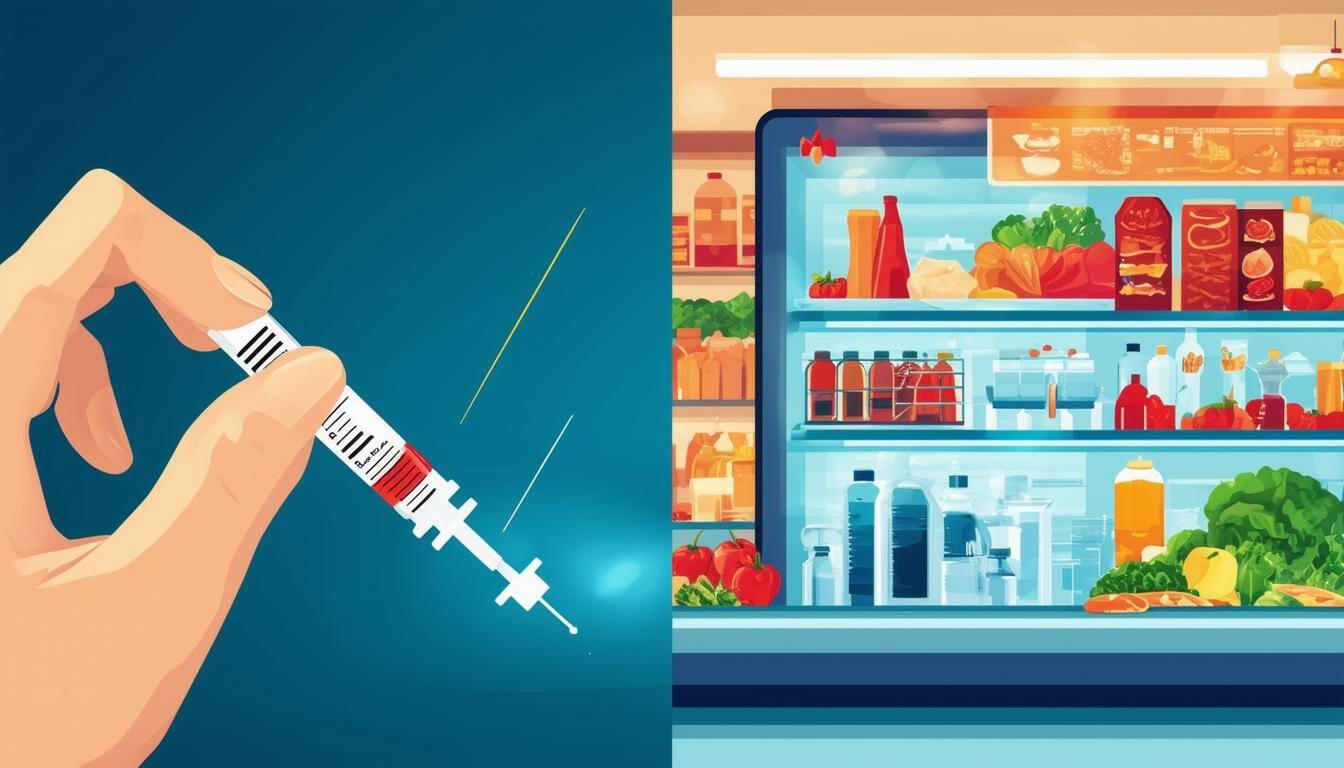There’s no denying the buzz around Ozempic and other GLP-1 drugs. Originally developed for diabetes, these medications were first approved for weight loss in 2014 with Saxenda, followed by Wegovy in 2021. Now, they’ve reshaped how we think about health, fitness, and food.

Here’s a startling fact:
Nearly 12% of American adults have tried or are currently taking a GLP-1 drug, according to a KFF poll. Even more surprising? Adults aged 18–29 are the leading users of these drugs for weight loss. 7% of adults aged 18-29 have used or are using GLP-1 drugs for weight loss compared to just 1% of those 65 and older.
Just take a look at the numbers below:
Adapted from: KFF Health Tracking Poll (April 23–May 1, 2024)
The surge in GLP-1 drug use isn’t just among adults—it's skyrocketing among younger adolescents too. A Michigan Medicine study found a 594% increase in the monthly number of adolescents and young adults (ages 12–25) using Wegovy, Ozempic, and similar medications from 2020 to 2023. The increase was particularly notable among young women, highlighting a growing reliance on these drugs for weight management at an early age.
Why Are So Many Young Adults Turning to GLP-1 Drugs?
It’s easy to point to TikTok trends or celebrity endorsements, but the reality is more complex—and concerning. With rising obesity rates, many young people are turning to GLP-1 drugs in search of effective weight loss solutions.
Just look at how BMI (Body Mass Index) trends in young adults have shifted over the past 30 years:
*Adapted from:NCHS Data Query System. BMI among adults, measured: Normal (BMI between 18.5 and 24.9). National Center for Health Statistics. *
- A normal BMI ranges from 18.5 to 24.9
- Thirty years ago, 57.9% of U.S. women and 51.1% of men aged 20–34 had a normal BMI
- As of 2018, only 36.6% of women and 32.3% of men in this age group fall within the normal BMI range, reflecting a significant decline in normal body weight
*Adapted from:NCHS Data Query System. BMI among adults, measured: Obesity (BMI greater than or equal to 30.0). National Center for Health Statistics. *
- A BMI of 30 or higher is classified as obese
- Thirty years ago, 18.5% of U.S. women and 14.1% of men aged 20–34 had a BMI in the obese range
- Since then, obesity rates have risen by 23.1% among men and 17.1% among women in this age group
While BMI isn’t a perfect measure—it doesn’t distinguish between muscle and fat—and a normal BMI isn’t the sole indicator of health, the rising obesity rates among young adults clearly suggest a troubling trend.
The GLP-1 Era: What It Means for the Future
Let’s be real: GLP-1 drugs aren’t a magic fix. Sure, they can give people a helpful boost on their weight loss journey, but the basics still hold true—sustainable weight loss is built on diet and exercise. Ever heard of the 70-30 rule? It’s said that 70% of weight loss success comes from what you eat, while exercise accounts for the remaining 30%.
Even insurance companies are catching on. Many now require patients to work with dietitians and adopt sustainable lifestyle changes before covering GLP-1 drugs for weight loss. More people are rethinking their relationship with food—and paying closer attention to where and what they eat.
Food Culture and the Shift Toward Ingredient Awareness
It’s not just about weight loss—young adults are increasingly more mindful of what’s in their food, and for good reason. Take Red Dye 3, for instance. This synthetic food coloring is found in our candy, sauces, drinks, and even medications in the U.S. While the FDA banned its use in cosmetics 35 years ago after studies linked it to cancer in rats, it continued to be used in food products we consume every day. That’s finally changing: a recent ban requires food companies to phase out Red Dye 3 by January 2027. This shouldn’t be too difficult since some food companies already changed their formulas when the dye was banned in the European Union in 1994.
Just to highlight how many additives go into our food in the U.S., let’s compare ingredient labels for Quaker Oats Strawberry Oatmeal. Same brand, but vastly different formulations: the U.S. version still contains controversial ingredients like artificial dyes, while the U.K. version—where additives like Red Dye 3 have long been restricted—you can see a much simpler ingredient list and actually read what you are eating.
This growing ingredient awareness has sparked a surge in ingredient-checking apps like Bobby Approved and my personal favorite Yuka, which helps consumers flag harmful additives and assess nutritional value just by scanning a product bar code in the app. People are scanning everything these days, from snacks to skincare. The numbers back it up— according to a recent survey by Insider Intelligence “nearly two-thirds (63.4%) of U.S. adults have used a health-related app in the past year".
So, the big question: can restaurants keep pace with this ingredient-savvy, health-conscious, tech-forward audience?
How Restaurants Can Adapt
It's time for restaurants, especially quick-service ones, to capitalize on the growing demand for better food options and quality ingredients. Restaurants can take advantage of the 70% of weight loss that is tied to food choices and start making changes to benefit the health-conscious consumer. Adding calorie counts to menus was a good start, but today’s diners are seeking more. Why not integrate restaurant menus to include scannable barcodes that link to calorie-counting apps like MyFitnessPal or ingredient-quality apps like Bobby Approved? Imagine scanning a menu to instantly access not only calorie counts but also information on added sugars, saturated fats, and preservatives and having that information uploaded seamlessly into your app of choice.
This kind of transparency could be a game-changer for restaurants looking to appeal to a health-conscious customer base. It’s no longer just about offering a low-calorie salad—it’s about letting diners see exactly what they’re putting into their bodies.
Restaurants that embrace this change—offering transparency, healthier options, and innovative tech integration—won’t just survive. They’ll thrive. The question is, who’s ready to lead the way?
- Julia Dunn





